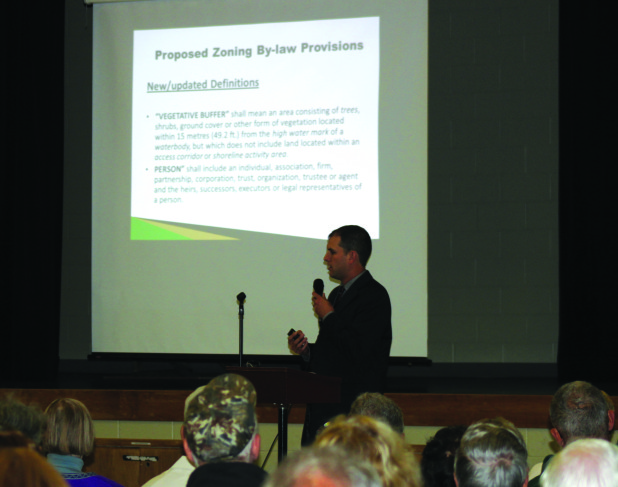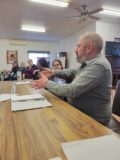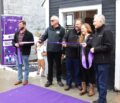Archive » Headline News » News
Public voices concerns over new vegetative buffer bylaw
May 26, 2015

By Nate Smelle
More than 150 people filled the gymnasium of the Hastings Highlands Centre in Maynooth on the morning of Saturday, May 23 for a public meeting regarding council’s proposed vegetative buffer bylaw. Deputy Mayor Mike Leveque got the ball rolling, welcoming the crowd before showing a video explaining why it is important for waterfront property owners to act as responsible stewards of the shorelines surrounding the lake(s) they enjoy.
The video looked at how a healthy natural shoreline helps to improve water quality and create habitat for fish and wildlife. Basically this means the larger the vegetative buffer around the shoreline, the healthier the lake. To further improve the water quality of the lake, it also suggested to only handle oil and gas away from the water because a single drop of oil can smother a bird egg.
Following the video presentation, Hastings County planner Justin Harrow described in detail how the proposed new bylaw would work. The purpose of the bylaw is to provide a clearer definition of what a vegetative buffer is and to determine where and how development is permitted to occur within the vegetative buffer. This draft of the bylaw requires 30 m setback from the high watermark, only requires 15 m wide vegetative buffer. It is being recommended that in order to remain consistent with the Provincial Policy Statement the municipality should consider increasing the required vegetative buffer 15 m to 30 m. It also proposes to allow waterfront property owners the opportunity to create an access corridor up to 20 m wide through the vegetative buffer in order to allow access to the shoreline. Answering a question which came up repeatedly during the question-and-answer period later on that morning Harrow stated that already existing cottages and structures would not be under scrutiny of the new bylaw.
“Existing cottages and properties where you already have your manicured lawns, your gardens, your sheds, your gazebos or whatever you may have on your property, where they are there they are permitted to be left there,” said Harrow.
“This bylaw is not retroactive, and it does not require that you to change anything. You will not need to plant new trees or shrubs or any of those things. What you have you are allowed to maintain.”
Once Harrow had finished his presentation the public was invited to voice their concerns about the bylaw to Council. Some of the concerns raised during the meeting included: whether or not the municipality could afford a new bylaw, how and by whom it was going to be enforced, and what it would mean for waterfront property owners.
Hastings Highlands former mayor, Ron Emond was one of the majority in the room opposed to to the new vegetative buffer bylaw. He believes the municipality simply can’t afford it.
“The person who is spending money on our lakes is spending between $500,000 to $1 million,” said Emond.
“If you think for one minute that people who are spending that kind of money want to put up with this kind of a bylaw you better think again. You folks are headed for litigation stream like you have never seen in your life. If you think your lawyer’s fees in the last two or three years have been big they were nothing compared to what they could be.”
Members from many of the area’s lake and cottage associations showed up to listen in on the presentations and to speak on behalf of their organization. The Baptiste Lake Association’s (BLA) lake plan coordinator and board member, David Hawkes was disappointed with the outcome of the proposed vegetative buffer bylaw. In 2011, he said the BLA hosted a workshop for the Hastings Highlands Council to brief them on the lake plan. Responsible for the coordination and implementation of the Baptiste Lake plan, Hawkes said one of its main focuses was shoreline protection. When putting the lake plan together the BLA surveyed all the residents on Baptiste Lake, asking them what their biggest concerns were. Clean water came out on top.
“The number one concern was water quality, and of course the shoreline has a direct impact on the water quality,” Hawkes said.
On Oct. 10, 2014 Hawkes and other members of the municipality’s shoreline protection committee met with staff from Hastings Highlands to come up with a first draft of what the new vegetative buffer bylaw should look like. Although this first draft did not meet all of their concerns, Hawkes said it was still better than the new bylaw currently on the table.
“I am very disappointed with the outcome,” said Hawkes.
“We went into this process acting in good faith, hoping for a more effective shoreline bylaw, where the lawbreakers face punishment if they decide to clear-cut their lot or bulldoze it to the water’s edge. These are egregious crimes against the lake and all of us bear the cost. At some point the water is going to be a problem.”
As the owner operator of Sunrise Lodge on Baptiste Lake for more than 30 years, Hillary Phillips sees great value in this legislation. After witnessing a developer purchase, clear-cut and abandon the waterfront lot next door to her resort she knows all too well how destructive some “development” can be. Watching helpless as the view from the resort she had enjoyed for more than three decades disappeared within less than an hour she decided to speak up in hopes that she could help others avoid having to cope with such a loss.
The devastation she has seen left behind by the developer next door to her property has had a lasting impact on the lake and those who live nearby. These type of “developments” also damage the local tourism industry for a number of reasons, she said, mainly because they destroy the natural beauty that brings people to the area.
“The aesthetic value of the area is what drives my business,” said Philips.
“The worst damage from the clear-cut is in the first three years. It goes right into the water and it doesn’t matter if it grows back later because the damage is done to that strip of water front and the fishing. The fishing has dropped so significantly that people are saying there are no fish in this Lake. Some people are just not good stewards and there has to be something in place because the people who I have seen doing these things don’t care. They just want what they want.”
Council will now consider the public’s input from this meeting before deciding whether or not to approve the vegetative buffer bylaw. Council meets again on Friday, June 5 at the Hastings Highlands Centre in Maynooth.


















